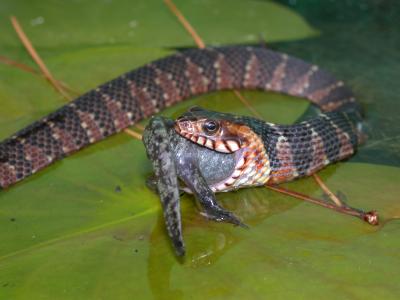Invasive watersnakes introduced to California may pose risk to native species

Southern watersnakes commonly eat mole salamanders, a group that includes two endangered species in California. A UC Davis study finds that the non-native snakes are invading California waters, posing a threat to native fish, amphibians and reptiles. Credit: J.D. Willson/University of Arkansas
Watersnakes, commonly seen in the lakes, rivers and streams of the eastern United States, are invading California waterways and may pose a threat to native and endangered species in the state, according to a University of California, Davis, study.
While scientists do not know exactly how many watersnakes are in California, roughly 300 individuals of two different species –the common watersnake and the southern watersnake — have been found in the Sacramento area (Roseville and Folsom), and at least 150 were seen in Long Beach. Researchers suspect the nonvenomous snakes most likely were introduced by people “setting free” their pet snakes.
“The issue is not yet out of control,” said lead author Jonathan Rose, a doctoral candidate in the UC Davis Graduate Group in Ecology. “However, we recommend that action be taken now to control emergent populations of these non-native snakes while they remain somewhat restricted in California. Waiting until they become entrenched could cost more ecologically and economically.”
The study, published today in the journal PLOS ONE, identified areas that would be climatically suitable for the watersnakes should their populations continue to increase. It found that potential distributions of watersnakes overlap with the giant gartersnake and the California tiger salamander — both on the federal list of threatened species — as well as the foothill yellow-legged frog, an amphibian of conservation concern. These native species can become prey or a competing species for the invasive watersnakes.
The common watersnake not only has the potential to spread through Central California, but also farther north to Oregon's Willamette Valley and to central Washington. The southern watersnake has a more restricted climatic niche but may spread through the Central Valley, where native fish and amphibians have already suffered significant declines. The two watersnake species also frequently interbreed, which could increase their invasiveness by producing hybrid genotypes able to tolerate a broader range of climates.
“Watersnakes are not picky eaters,” said co-author Brian Todd, a conservation biologist in the UC Davis Department of Wildlife, Fish and Conservation Biology. “With their predatory nature and generalist diets, our already imperiled native fish, amphibians and reptiles have much to lose should introduced watersnakes become more widespread.”
Nearly half of California's amphibians are considered Species of Special Concern or are listed under the state or federal Endangered Species Act, and more than 80 percent of the state's inland fishes are of conservation concern.
Sightings of introduced watersnakes can be reported to californiawatersnakes@gmail.com.
Read the full study at http://bit.ly/1lTT0lg.
Media Contact
All latest news from the category: Ecology, The Environment and Conservation
This complex theme deals primarily with interactions between organisms and the environmental factors that impact them, but to a greater extent between individual inanimate environmental factors.
innovations-report offers informative reports and articles on topics such as climate protection, landscape conservation, ecological systems, wildlife and nature parks and ecosystem efficiency and balance.
Newest articles

A universal framework for spatial biology
SpatialData is a freely accessible tool to unify and integrate data from different omics technologies accounting for spatial information, which can provide holistic insights into health and disease. Biological processes…

How complex biological processes arise
A $20 million grant from the U.S. National Science Foundation (NSF) will support the establishment and operation of the National Synthesis Center for Emergence in the Molecular and Cellular Sciences (NCEMS) at…

Airborne single-photon lidar system achieves high-resolution 3D imaging
Compact, low-power system opens doors for photon-efficient drone and satellite-based environmental monitoring and mapping. Researchers have developed a compact and lightweight single-photon airborne lidar system that can acquire high-resolution 3D…





















